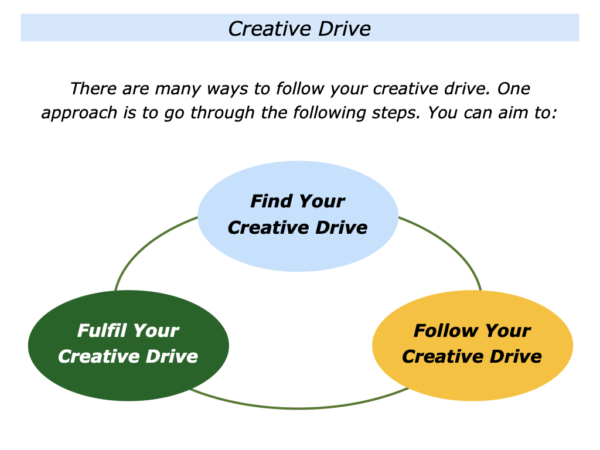
When do you feel most creative? When do you want to follow your creative drive? What do you feel when you have fulfilled your creative drive?
Different people feel compelled to create different things. They may want to help people, create encouraging environments, nurture beautiful gardens, design houses, make things work better or do another activity.
Creativity is something we often channel and obey. It is not something we own. But we do own the responsibility to our best with the gift we have been given.
Everybody is an artist, everybody is creative, everybody has something special to give to the world. People can be encouraged to channel these gifts to help other people.
This approach was described by Antoine de Saint-Exupéry in his book Wind, Sand and Stars. He describes a long train journey in a crowded carriage in which he ponders on the possibilities within each human being.
I sat down face to face with one couple. Between the man and the woman a child had hollowed himself out a place and fallen asleep.
He turned in his slumber, and in the dim lamplight I saw his face. What an adorable face! I bent over the smooth brow, over those mildly pouting lips, and I said to myself: This is a musician’s face.
This is the child Mozart. This is a life full of beautiful promise. Little princes in legends are not different from this. Protected, sheltered, cultivated, what could not this child become.
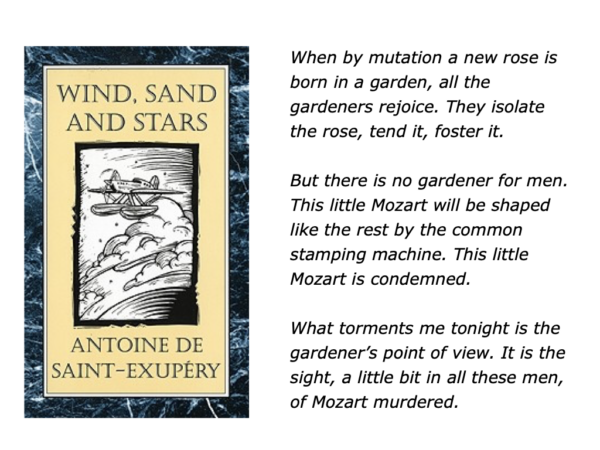
This passage fed my own desire to encourage people. You will have your own drivers that urge you to create. Imagine that you want to follow such drives. The following pages explore how you may be able to do this in your own way.
You Can Find
Your Creative Drive
Some people get creative ideas out of the blue. Some get them at certain times of the day. One person described their approach in the following way.
“I often get creative ideas at dawn. Or, more accurately, the time between waking up and being fully conscious.
“At night I think about what I want to work on the next day. Then I let the ideas incubate. This works for me, but I know other people have other approaches.”
How can you find and feed your creative drive? One approach is to ask yourself the following questions.
When do I feel most creative? When do I feel most alive? How can I create fertile ground for getting ideas? What are the times of day when I get ideas? What gives me positive energy? What are the conditions that sometimes facilitate ideas? How can I feed my creative drives?
Some people get ideas when doing certain activities. They may be having a bath, listening to the rain or simply pottering around.
Some get ideas when being in certain environments. They may be in their favourite place, playing music or appreciating beauty.
Some get ideas when doing what works for them. They may be recalling past experiences, learning from positive models or studying success.
How can you find and feed your creative drive? How can you do what works for you? How can you give your creative ideas time to incubate?
You Can Follow
Your Creative Drive
There are many ways to be creative. One approach is to do something you care about and then focus on the following themes.
Clarity
This involves clarifying the real results you want to achieve.
Creativity
This involves following your chosen methods for being creative.
Concrete Results
This involves doing your best to achieve the desired concrete results.
Imagine that you have found a creative drive you want to pursue. If appropriate, you can then explore the following questions.
What is the creative drive I want to follow? How can I translate this into doing a specific project? What would like to achieve by doing such a project? What is the picture of success?
How can I do my best to achieve these goals? How can I build on my strengths and follow my successful style? What are the key strategies I can follow to give myself the greatest chance of success?
The following pages explore some approaches to following your creative drive. Let’s start with one that people often follow when pursuing their passions or interests.
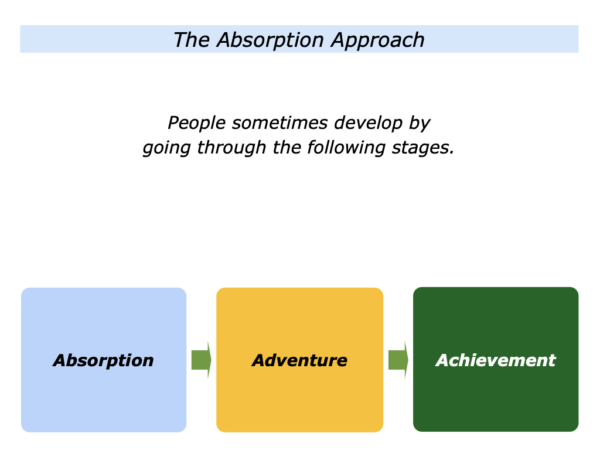
Imagine that you want to do good work. Sometimes this involves going through the stages of absorption, adventure and achievement.
You may take this approach when writing, gardening, painting, running or doing another activity. You may do so when encouraging a person, doing a project, running a workshop, leading a team or reframing a challenge.
People often feel alive when taking these steps. They enjoy the process of exploring, learning and creating. They may then reach their aim and enjoy a sense of achievement.
One key point is worth bearing in mind. Different people have different definitions of achievement. This can be useful to remember when encouraging other people to develop.
For some people achievement means enjoying an experience, helping others to grow or creating positive memories. For some it means gaining a badge, winning a prize or reaching a target. Let’s explore how you can explore some of these steps in your own way.
Absorption
Imagine that you want to absorb yourself in a specific project. You may simply want to do it for pleasure or to experience joy. This can be good for the soul. It can you give you positive energy and be fulfilling.
You may want to translate your chosen activity into achieving a specific goal. This could be writing an article, renovating a house, developing a skill, solving a problem, tackling a challenge or your definition of success.
How can you absorb yourself in the activity? How can you move into action? How can you be fully engaged? How can you see it as a positive adventure?
Adventure
Maria Montessori, the educator, said that children often become absorbed in an activity. They apply themselves, learn and enjoy the adventure of being creative. Finally they reach their goal and experience a sense of achievement.
Imagine that you want to pursue a particular activity or project. You may set aside time to write, cook, sing or do mountain biking. You may aim to do a creative project, tackle a challenge or do another stimulating activity.
How can you use your abilities on the adventure? How can you build on your strengths? How can you improve your skills and add to your repertoire? How can you continue to develop?
Many people love to explore, learn and adventure. Sometimes this can involve pursuing the following aspects of the creative process.
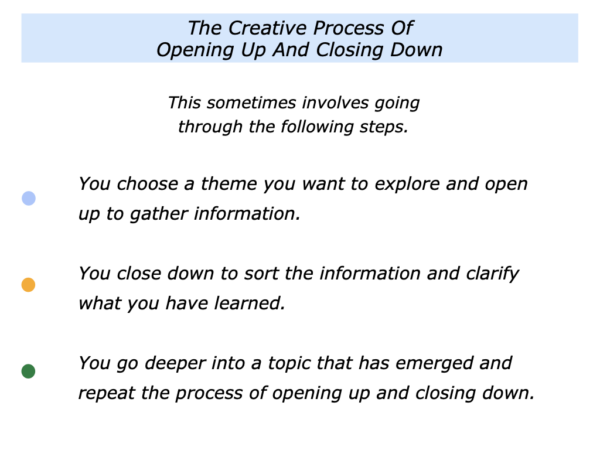
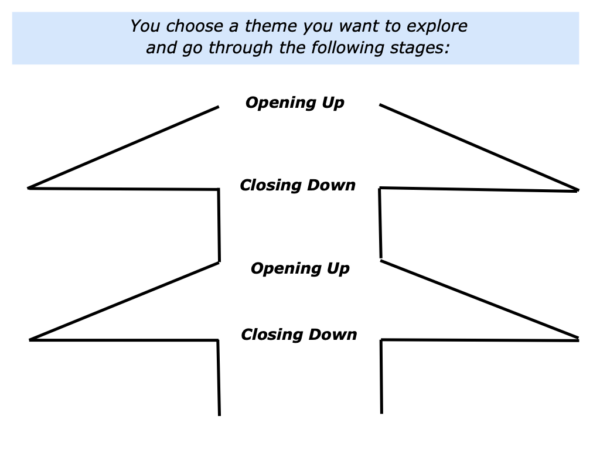
Imagine that you are following this approach. You may start by choosing to focus on a particular theme you want to explore.
This will involve opening up and gathering lots of information. After a while you will want to summarise what you have learned. This will lead to closing down and clarifying what you have learned.
The information you have gathered may reveal topics you want to explore in more depth. You may again go through the process of opening up and closing down until you feel ready to move into action.
Clicking into action, you will build on your strengths and add what you have learned. Applying your skills, you will continue until you feel satisfied with the piece of creative work.
There are several points to bear in mind when following this approach. The first is knowing when to open up and when to close down.
The second is knowing when to move into action. You will have gathered lots of knowledge, but it will be important to apply this in practise. This can only be done by moving into action.
Sometimes you may not feel ready but decide to start the work. Believing that some answers may emerge on the journey, you say:
“Let’s crack on and do version 1.0”
Achievement
Imagine that you are pursuing an activity or doing a project. You will absorb yourself in the task and continue to develop. You may also work towards achieving a specific aim.
Sometimes the aim may be emotional. It may be to enjoy an experience or help others to take away positive memories. Sometimes the aim may be more tangible. It may be to see a finished product, achieve a target or lift a prize.
As mentioned earlier, people have different definitions of achievement. This is governed by what they set out to do. Bearing in mind what they can control, here are some things that people have said regarding what they want to achieve.
The specific things I want to achieve
by doing the activity or project are:
To regain my zest for life … To create nourishing meals that give people enjoyment … To provide a framework in which people can find fulfilment … To share knowledge that enables people to shape their futures.
To make music that some people find inspiring … To give people positive memories … To achieve a personal best in a triathlon … To lead a yachting team around the world and back home safely …
To produce three players every year who move from the Academy to the First Team … To make television films that encourage people to care for animals … To create a successful social enterprise … To build and sell a pioneering company.
You Can Fulfil
Your Creative Drive
Imagine that you are pursuing your chosen activity. You will aim to encourage yourself and enjoy the journey along the road. You will then aim to finish superbly and gain a sense of fulfilment.
Different people take these steps in different ways. Some people follow their creative drive, focus on continuous improvement and sometimes get a sense of contentment.
Such people may pause for a while but then follow these steps again. They feel alive and find it fulfilling to keep following this circle. The journey is the goal and the goal is the journey.
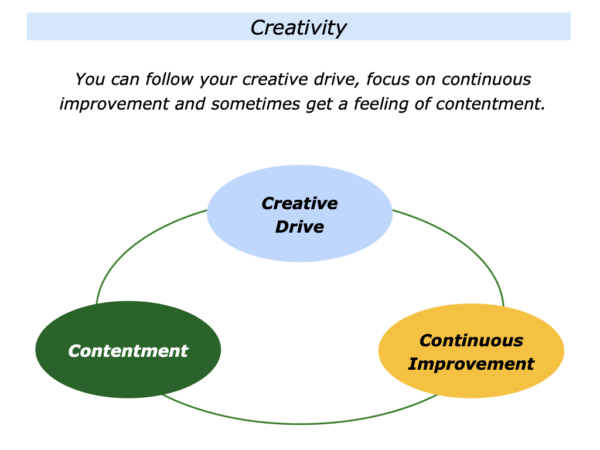
How to take these steps? You will organise your time in your own way, but one model is similar to designing your perfect day. Let’s explore this approach.
The My Creative Day Approach
Imagine you wanted to design your perfect creative day. What would it look like? Let’s consider some of the themes it can be useful to explore when designing such a day.
When do you feel most creative? What are your prime times – the times of the day when you have most creative energy? How can you organise your day around these times?
What is the physical place where you feel most creative? This could be a certain part of the house or another place. How can you continue putting yourself in these places?
What are things that can trigger your creativity? You may get ideas when walking, exercising, listening to music or other situations. How can you continue doing some of these things?
You will have your own way of doing creative work, but here are some suggestions. You may wish:
To follow your chosen way to start the day – such as when to get up and do any practical tasks – and also focus on what you want to achieve that day;
To make good use of your prime times – the times of the day when you have most creative energy – and organise blocks of time when you can work during those times;
To follow your ritual for starting the work, follow your chosen rhythm and achieve small goals on the road to achieving the bigger goal;
To, when appropriate, rest and recharge your batteries – such as by going for a walk or doing other things – and then focus on what you want to do next;
To follow your successful pattern for finishing – such as one you have followed before to finish properly – then to flow, focus, finish and find fulfilment.
Let’s return to your own life and work. If you wish, try tackling the exercise on this theme. This invites you to complete the following sentences.
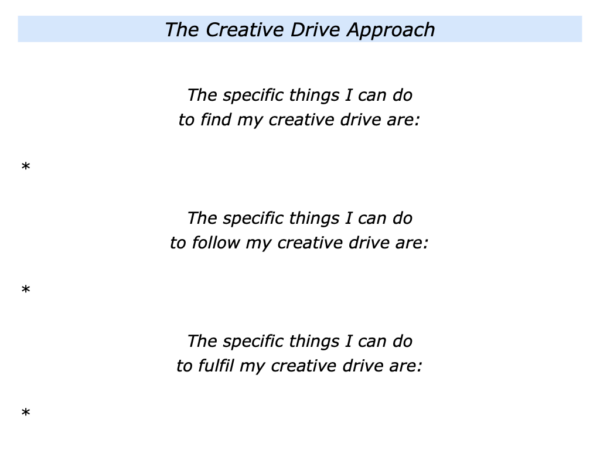






Leave a Reply